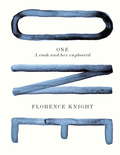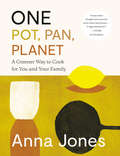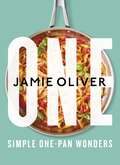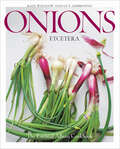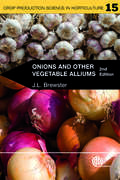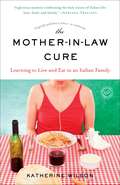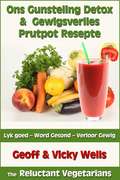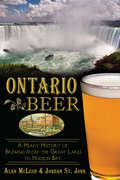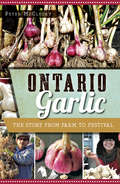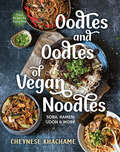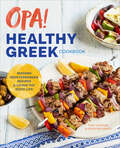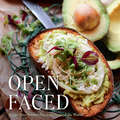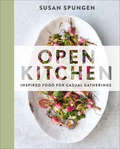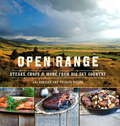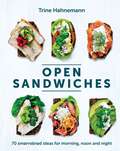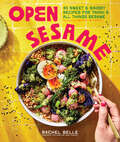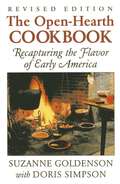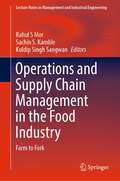- Table View
- List View
One-dish Dinners: 100 Easy Everyday Meals
by Rodale PressInside, you'll see recipes full of your favorites, including chicken, beef, and pasta dishes that cook quickly and taste great. Plus, a variety of seafood, fish, and pork dishes, destined to become hits and they all cook in just one pot, pan, or dish.
One: A Cook and Her Cupboard
by Florence KnightCooking's new golden girl. GuardianThe new kitchen goddess. Daily MailEach chapter in One focuses on recipes built around one particular store cupboard ingredient, such as ketchup, oil, salt and honey. The result is a host of modern European dishes that have appeal, longevity and a touch of elegance to boot. OliveShe made her name as head chef at London's Polpetto and now Florence Knight has brought out her first book, One. In it, she turns to the kitchen cupboard to create no-nonsense but creative food from her favourite ingredients - proving just how much can be achieved with a bottle of ketchup and some imagination. Waitrose KitchenFlorence is the next big thing in cooking. Observer Food Monthly'Less is more' typifies Florence's style. She cooks with delicacy and almost poetic simplicity but with a meticulous attention to detail that manifests itself in dishes of rare and delightful flavours. Russell Norman, Polpo
One: A Cook and Her Cupboard
by Florence KnightCooking's new golden girl. GuardianThe new kitchen goddess. Daily MailEach chapter in One focuses on recipes built around one particular store cupboard ingredient, such as ketchup, oil, salt and honey. The result is a host of modern European dishes that have appeal, longevity and a touch of elegance to boot. OliveShe made her name as head chef at London's Polpetto and now Florence Knight has brought out her first book, One. In it, she turns to the kitchen cupboard to create no-nonsense but creative food from her favourite ingredients - proving just how much can be achieved with a bottle of ketchup and some imagination. Waitrose KitchenFlorence is the next big thing in cooking. Observer Food Monthly'Less is more' typifies Florence's style. She cooks with delicacy and almost poetic simplicity but with a meticulous attention to detail that manifests itself in dishes of rare and delightful flavours. Russell Norman, Polpo
One: A Greener Way to Cook for You and Your Family: A Cookbook
by Anna JonesFrom the award-winning culinary superstar and all-around &“Queen of the Greens,&” a cookbook that perfectly reflects the way we want to cook and eat today: vegetarian food that is stylish, sustainable, and packed with flavor."This is a book where thought meets practical action meets deliciousness." –Yotam Ottolenghi, bestselling author and award-winning chef With her award-winning cookbooks, Anna Jones blazed the trail of modern and creative vegetable-centered cuisine, and in her new book, she makes cooking mouthwatering meals simpler and greener than ever before. One: Pot, Pan, Planet delivers all the goods: delectable recipes that are easy to prepare and that keep sustainability at the center of every dish. And with Jones guiding the way, the variety and depths of flavors possible using just one pot, pan, or tray are limitless: Persian Noodle Soup, Carrot & Sesame Pancakes; Crispy Butter Beans with Kale, Lemon & Parmesan; Quick Squash Lasagna; Saag Aloo Shepard's Pie, to name just a few. With over 200 recipes for every occasion--from busy weeknight meals, to weekend feasts, to desserts that promise to delight --these inventive, deeply satisfying dishes will become your new go-to kitchen staples. Whether preparing the recipes vegetarian or vegan, you will also find information to help you reduce waste, use leftovers, make kitchens plastic-free, and become a more environmentally mindful shopper. One: Pot, Pan, Planet is a splendid cookbook that is all good: for you, for your pocket, for the planet--and, of course, for your palate!
One: [American Measurements]
by Jamie OliverNEW YORK TIMES BESTSELLERWALL STREET JOURNAL BESTSELLERPUBLISHERS WEEKLY BESTSELLEROne is the ultimate cookbook that will make getting good food on the table easier than ever before . . . Jamie Oliver is back to basics with over 120 simple, delicious, ONE pan recipes. This edition has been adapted for the US market.In ONE, Jamie Oliver will guide you through over 120 recipes for tasty, fuss-free and satisfying dishes cooked in just one pan. What’s better: each recipe has just eight ingredients or fewer, meaning minimal prep (and cleaning up) and offering maximum convenience.Packed with budget-friendly dishes you can rustle up any time, ONE has everything from delicious work from home lunches to quick dinners the whole family will love; from meat-free options to meals that will get novice cooks started.With chapters including . . .· Veggie Delights· Celebrating Chicken· Frying Pan Pasta· Batch CookingSimple dishes like Juicy Tahini Chicken and Hassleback Eggplant Pie and will soon become your new favorites.There are plenty more no-fuss, tasty recipes that make ONE sit alongside 5 Ingredients and Ultimate Veg as your go-to kitchen companions.
Onions Etcetera: The Essential Allium Cookbook
by Kate Winslow Guy AmbrosinoMore than 130 supermarket-friendly recipes, all from the indispensable Alliums: leeks, chives, garlic, shallots, scallions, and every other type of onion!Whether you delight in the hunt for scapes, your favorite heirloom cipollini, the spice of raw garlic, or the sweetness of caramelized onions, Onions Etcetera is the right place for you. This book is for all the Allium lovers out there; all of you who can’t imagine cooking dinner without at least one onion in the mix. In Onions Etcetera you’ll explore the wonderful versatility of the humble onion as you learn to coax out flavors familiar and unknown.From classics and family favorites, to more obscure recipes, you’ll find 130 onion-centric dishes, including:Za’atar Onion Petals with Beets and LabnehPearl Onion Tarte TatinAppalachian ChimichurriCurried Onion Fritters with Mint RaitaGrilled Delicata Squash with Shallot AgrodolceCheese and Allium ToastiesEggplant Salad with Black Garlic Tahini DressingScallion Sesame PancakesGrilled Fish with Charred Garlic Scape RelishAnd that’s just a start, fellow onion lovers. Grab your chef’s knife, your favorite member of the Allium family, and Onions Etcetera, of course, and get cooking!“I don’t believe there is a single recipe in this book I don’t want to cook.” —Nigella Lawson“Magnificent, as perfect as a cookbook can be . . . You want supreme food and don’t have time to visit Paris? Open the pages of Onions Etcetera and explore the world.” —Huffington Post“In this gorgeous book, onions finally get their star turn. The recipes will surprise and seduce you; you will want to cook every single one.” —Ruth Reichl
Onions and Other Vegetable Alliums (2nd edition)
by James L. BrewsterThis edition relates the production and utilization of the familiar and important vegetable crops to the many aspects of plant science underpinning their production and storage technologies. Chapters cover species and crop types, plant structure, genetics and breeding, physiology of growth and development and also pests and diseases, production agronomy, storage after harvest and the biochemistry of flavor, storage carbohydrates and color and how this relates to nutritional and health benefits.
Only Murders in the Abbey: An absolutely gripping and witty Golden Age cozy murder mystery (A Loch Down Abbey Mystery)
by Beth Cowan-Erskine'Wonderful read and a great whodunnit with all the intriguing clues and red herrings... I highly recommend this as a great read if you're looking for a murder mystery, a bit of humour and an escape' Reader review ⭐⭐⭐⭐⭐'Mrs MacBain, thank god it's you.' Without another word, he grabbed her arm and pulled her into the room, locking the door behind them. Mrs MacBain turned around, clearly offended at being manhandled, but then gasped, 'Is that blood?'Loch Down Abbey is full of guests for a Highland Ball. Including several uninvited members of the Inverkillen clan, the Abbey's former residents. Housekeeper Mrs MacBain thinks her biggest challenge will be finding suitable rooms for everyone and keeping the peace at cocktail hour.Until the morning after the ball, when one of the guests is discovered inside the Abbey's library - as dead as a doornail.Who would have had motive to want them dead? And how did they manage to commit their crime and escape while keeping the door locked from the inside? With an Abbey full of suspects and secrets, it is down to Mrs MacBain to catch the killer before they strike again... A brilliantly twisty and deliciously witty Golden Age murder mystery to transport you to 1930s Scotland. Perfect for fans of Agatha Christie, Janice Hallett and Richard Osman. Readers love Only Murders in the Abbey:'This cosy crime novel will keep readers on their toes... It's both a lot of fun to read and to try and work out the culprit' Reader review ⭐⭐⭐⭐⭐'Fun cosy murder story. Lots of colourful characters... Such a good mystery with a few twists and turns. A most enjoyable book' Reader review ⭐⭐⭐⭐⭐'Just brilliant' Reader review ⭐⭐⭐⭐⭐'A fabulously written gripping story that was a pleasure to read. I would absolutely recommend this book, it was brilliant' Reader review ⭐⭐⭐⭐⭐
Only Murders in the Abbey: An absolutely gripping and witty Golden Age cozy murder mystery (A Loch Down Abbey Mystery)
by Beth Cowan-Erskine'Mrs MacBain, thank god it's you.' Without another word, he grabbed her arm and pulled her into the room, locking the door behind them. Mrs MacBain turned around, clearly offended at being manhandled, but then gasped, 'Is that blood?' Loch Down Abbey is full of guests for a Highland Ball. Including several uninvited members of the Inverkillen clan, the Abbey's former residents. Housekeeper Mrs MacBain thinks her biggest challenge will be finding suitable rooms for everyone and keeping the peace at cocktail hour. Until the morning after the ball, when one of the guests is discovered inside the Abbey's library - as dead as a doornail. Who would have had motive to want them dead? And how did they manage to commit their crime and escape while keeping the door locked from the inside? With an Abbey full of suspects and secrets, it is down to Mrs MacBain to catch the killer before they strike again...
Only Murders in the Abbey: An absolutely gripping and witty Golden Age cozy murder mystery (A Loch Down Abbey Mystery)
by Beth Cowan-Erskine'Wonderful read and a great whodunnit with all the intriguing clues and red herrings... I highly recommend this as a great read if you're looking for a murder mystery, a bit of humour and an escape' Reader review ⭐⭐⭐⭐⭐'Mrs MacBain, thank god it's you.' Without another word, he grabbed her arm and pulled her into the room, locking the door behind them. Mrs MacBain turned around, clearly offended at being manhandled, but then gasped, 'Is that blood?'Loch Down Abbey is full of guests for a Highland Ball. Including several uninvited members of the Inverkillen clan, the Abbey's former residents. Housekeeper Mrs MacBain thinks her biggest challenge will be finding suitable rooms for everyone and keeping the peace at cocktail hour.Until the morning after the ball, when one of the guests is discovered inside the Abbey's library - as dead as a doornail.Who would have had motive to want them dead? And how did they manage to commit their crime and escape while keeping the door locked from the inside? With an Abbey full of suspects and secrets, it is down to Mrs MacBain to catch the killer before they strike again... A brilliantly twisty and deliciously witty Golden Age murder mystery to transport you to 1930s Scotland. Perfect for fans of Agatha Christie, Janice Hallett and Richard Osman. Readers love Only Murders in the Abbey:'This cosy crime novel will keep readers on their toes... It's both a lot of fun to read and to try and work out the culprit' Reader review ⭐⭐⭐⭐⭐'Fun cosy murder story. Lots of colourful characters... Such a good mystery with a few twists and turns. A most enjoyable book' Reader review ⭐⭐⭐⭐⭐'Just brilliant' Reader review ⭐⭐⭐⭐⭐'A fabulously written gripping story that was a pleasure to read. I would absolutely recommend this book, it was brilliant' Reader review ⭐⭐⭐⭐⭐
Only in Naples: Lessons in Food and Famiglia from My Italian Mother-in-Law
by Katherine WilsonFull of lighthearted humor, sumptuous food, the wisdom of an Italian mother-in-law, and all the atmosphere of Elena Ferrante's Neapolitan Novels, this warm and witty memoir follows American-born Katherine Wilson on her adventures abroad. Thanks to a surprising romance--and a spirited woman who teaches her to laugh, to seize joy, and to love--a three-month rite of passage in Naples turns into a permanent embrace of this boisterous city on the Mediterranean.When I saw the sea at Gaeta, I knew that Naples was near and I was coming home."There is a chaotic, vibrant energy about Naples that forces you to let go and give in," writes Katherine, who arrives in the city to intern at the United States Consulate. One evening, she meets handsome, studious Salvatore and finds herself immediately enveloped by his elegant mother, Raffaella, and the rest of the Avallone family. From that moment, Katherine's education begins: Never eat the crust of a pizza first, always stand up and fight for yourself and your loved ones, and consider mealtimes sacred--food must be prepared fresh and consumed in compagnia. Immersed in Neapolitan culture, traditions, and cuisine, slowly and unexpectedly falling for Salvatore, and longing for Raffaella's company and guidance, Katherine discovers how to prepare meals that sing, from hearty, thick ragù to comforting rigatoni alla Genovese to pasta al forno, a casserole chock-full of bacon, béchamel, and no fewer than four kinds of cheeses. The secret to succulent, tender octopus? Beat it with a hammer. While Katherine is used to large American kitchens with islands and barstools, she understands the beauty of small, tight Italian ones, where it's easy to offer a taste from a wooden spoon. Through courtship, culture clashes, Sunday services, marriage, and motherhood (in Naples, a pregnancy craving must always be satisfied!), Katherine comes to appreciate carnale, the quintessentially Neapolitan sense of comfort and confidence in one's own skin. Raffaella and her famiglia are also experts at sdrammatizzare, knowing how to suck the tragedy from something and spit it out with a great big smile. Part travel tale, part love letter, Only in Naples is a sumptuous story that is a feast for the senses. Goethe said, "See Naples and die." But Katherine Wilson saw Naples and started to live. Advance praise for Only in Naples "In a world filled with food memoirs, this one stands out. Katherine Wilson gives us more than the fabulous food of Naples. She offers us a passport to an exotic country we would never be able to enter on our own."--Ruth Reichl, author of My Kitchen Year"Wilson has written a glorious memoir celebrating the holy trinity of Italian life: love, food, and family. Her keen eye and sense of humor take you through the winding streets of Naples at a clip, on a ride you hope will never end."--Adriana Trigiani, author of The Shoemaker's Wife "How lucky we are to get these hilarious and wise perceptions filtered through a sincerely loving eye."--Julie Klam, author of Friendkeeping "This thoroughly enjoyable love letter to Naples is a tribute to the author's irrepressible mother-in-law."--Luisa Weiss, author of My Berlin Kitchen and founder of The Wednesday Chef "Wilson's easygoing writing perfectly suits this tale of an innocent abroad, an American girl who discovers herself in the midst of a foreign culture that becomes, in the end, her own."--Kate Christensen, author of How to Cook a MooseFrom the Hardcover edition.
Ons Gunsteling Detox & Gewigsverlies Prutpot Resepte
by Geoff Wells Vicky Wells Corlia JonesOns is dol oor prutpot etes want hulle is maklik, gerieflik en lekker. Nog beter is prutpot etes wat jou help om gewig te verloor en gesond te word en bly. Jy sal vind dat wanneer jy 'n vegetariese or vegan dieet volg, jy 'n baie meer voedingstof-digte voedsel eet terwyl jou kalorieë baie laag gehou word. Dit is nie te sê dat ALLE vegan en vegetariese kos lae-kalorie is nie. Jy sal nogsteeds jou inname van vette en hoër kalorie kosse moet dophou, maar jy sal ook vind dat jy die "versadige" gevoel langer behou omdat jou liggaam meer van die noodsaaklike voedingstowwe opneem. Sommige van die resepte is goed vir detox en hulle is sodanig gemerk. Al die resepte Is vegetaries of vegan en meeste van hulle sal ook help met gewigsverlies. Party van die nagereg resepte is 'n bietjie hoër in kalorieë so gebruik dit spaarsamig.
Ontario Beer: A Heady History of Brewing from the Great Lakes to Hudson Bay
by Jordan St. John Alan McleodBeer historians and writers Alan McLeod and Jordan St. John have tapped the cask of Ontario brewing to bring the complete story to light, from foam to dregs. Ontario boasts a potent mix of brewing traditions. Wherever Europeans explored, battled, and settled, beer was not far behind, which brought the simple magic of brewing to Ontario in the 1670s. Early Hudson's Bay Company traders brewed in Canada's Arctic, and Loyalist refugees brought the craft north in the 1780s. Early 1900s temperance activists drove the industry largely underground but couldn't dry up the quest to quench Ontarians' thirst. The heavy regulation that replaced prohibition centralized surviving breweries. Today, independent breweries are booming and writing their own chapters in the Ontario beer story.
Ontario Garlic: The Story from Farm to Festival
by Peter MccluskyThe taste of Ontario garlic is as rich and varied as its history. Used mainly for medicinal purposes in the nineteenth century, people turned up their noses at the aromatic bulb as it became associated with new immigrants. The once acceptable ingredient became undesirable in church and school--kids who smelled of garlic were sent home. Pioneering chefs, farmers and a wave of cultural diversity have brought the zesty allium into the mainstream, making it a gourmand's go-to spice, celebrated at nine festivals across the province. Toronto Garlic Festival founder Peter McClusky serves up garlic's long journey from central Asia to its now-revered place in the hearts and dishes of Ontarians. Growing tips and forty recipes bring Ontario garlic from farm to festival to feast.
Onward: How Starbucks Fought for Its Life without Losing Its Soul
by Howard SchultzSchultz's story of how he transformed a failing company back to sustained, profitable growth. He offers readers an extraordinarily intimate look at his daily decision-making process, from closed-door planning sessions in Seattle, to conversations with coffee farmers in Rwanda, to investor presentations in New York during the worst of the economic turmoil.
Oodles and Oodles of Vegan Noodles: Soba, Ramen, Udon And More--easy Recipes For Every Day
by Cheynese KhachameThe first plant-based, pan-Asian noodle cookbook, featuring classics made vegan and exciting innovations Soba, ramen, udon, pho—saucy, slurpy noodles of every kind go vegan in this sunny cookbook. TikTok sensation Cheynese Khachame shares her noodle love, with over 50 dishes representing Japan, Korea, Thailand, China, and beyond . . . Soba Salad with Spicy Peanut Dressing to fill your belly at lunch Creamy Coconut-Curry Ramen for comfort food in 20 minutes (!) Steamy Drunken Noodles to pick you up after a night out Vietnamese Pho that turns simple spices into taste-bud bliss Cheynese’s lovingly crafted recipes meet every craving with 100 percent plant-based ingredients: from summery japchae and zaru soba to classic shoyu ramen and fusion udon “carbonara.” For noodle fans seeking oodles of options, these are soups, salads, and stir-fries simply not to be missed!
Opa! The Healthy Greek Cookbook: Modern Mediterranean Recipes for Living the Good Life
by Theo Stephan Christina XenosNatural Greek cuisine this healthy and this delicious has never been this easy. Bring the healthy and mouthwatering flavors of Greece home with Opa! The Healthy Greek Cookbook. Filled with traditional dishes, this Greek cookbook combines great tastes with food that's good for you. From Kalamata Olive Spread and Vegetable Moussaka to Shrimp Santorini and Spinach and Feta Stuffed Chicken Breasts, these dishes will have you shouting "Opa!" Worried about finding the right ingredients? This Greek cookbook brings you authentic dishes without needing to visit the Mediterranean to shop. Learn how to stock your pantry, explore Greek flavor profiles, and master cooking techniques. Opa! The Healthy Greek Cookbook includes: 90 healthy Greek recipes—Discover how easy it is to craft sumptuous Greek dishes in your kitchen using easy-to-find ingredients and simple instructions. Helpful tips and tricks—This Greek cookbook is filled with handy suggestions for substituting ingredients, advice for better cooking, timesavers, and more. Live Greek—Get insight into why Greek food is so good for you—as well as healthy lifestyle tips drawn straight from Greece. Eat healthy without sacrificing flavor thanks to Opa! The Healthy Greek Cookbook.
Open Faced: Single-Slice Sandwiches from Around the World
by Karen KaplanToasted tradition gets a modern makeover in this cookbook from a former writer and editor at Bon Appétit.Open Faced crosses international borders to bring fresh, creative flavors to your toasted breakfast, brunch, lunch, or dinner. Discover butterbrote, montaditos, smørrebrød, and other open-faced sandwiches that capture the essence of Germany, Spain, Scandinavia, France, Italy, and more.Go beyond butter with inspired flavors like:• Provençal Tuna and Vegetable Salad• Cider and Honey-Scented Onion Marmalade, Cabrales Cheese, and Hazelnuts• Curried Egg Salad with Mango Chutney, Raisins, and Cashews• Meatballs with Beet and Apple SaladWith easy yet elegant recipes and romantic photography, this cookbook makes a striking gift for anyone who finds comfort in a warm slice of bread.&“The open-faced sandwich trend is here to stay. This cookbook, with its easy-to-follow recipes and interesting backstories, is a total crowd-pleaser.&”—Robert Irvine, Food Network host &“You gotta check out this book. You get takes on recipes from around the world and some killer originals. This ain't your little kid&’s grilled cheese cookbook.&”—Guy Fieri, Food Network host &“I simply love Karen&’s fresh approach to one of my favorite things in the world―the humble sandwich. It&’s both simple and sophisticated, but most importantly, the recipes work.&”—Curtis Stone, celebrity chef &“A delightful new take on toast. Loaded with colorful, creative, and easy-to-make recipes, Open Faced is just what you want: comfort from a great piece of bread with toppings of flavor and adventure.&”—Jeanne Kelley, author ofKitchen Garden Cookbook
Open Kitchen: Inspired Food for Casual Gatherings
by Susan SpungenSimple, stylish recipes for fearless entertaining from the renowned food stylist, New York Times contributor, and founding food editor of Martha Stewart Living.As a professional recipe developer, avid home cook, and frequent hostess, Susan Spungen is devoted to creating perfectly simple recipes for good food. In Open Kitchen, she arms readers with elegant, must-make meal ideas that are easy to share and enjoy with friends and family.An open kitchen, whether physical or spiritual, is a place to welcome company, to enjoy togetherness and the making of a meal. This cookbook is full of contemporary, stylish, and accessible dishes that will delight and impress with less effort. From simple starters such as Burrata with Pickled Cherries and centerpieces such as Rosy Harissa Chicken, to desserts such as Roasted Strawberry-Basil Sherbet, the dishes are seasonal classics with a twist, vegetable-forward and always appealing. Filled with practical tips and Susan's "get-ahead" cooking philosophy that ensures streamlined, stress-free preparation, this cookbook encourages readers to open their kitchens to new flavors, menus, and guests.Perfect for occasions that call for simple but elevated comfort food, whether it's a relaxed gathering or a weeknight dinner, Open Kitchen shows readers how to maximize results with minimal effort for deeply satisfying, a little bit surprising, and delicious meals. It is a cookbook you'll reach for again and again.
Open Range: Steaks, Chops, and More from Big Sky Country
by Patrick Dillon Jay BentleyNot just a major vacation destination, Montana is a veritable melting pot of delicious grub. Add to it the wide-open spaces, outdoor living, and the riches of nature, and it’s enough to make any vacationer question the decision to go home! Prepare yourself for what the authors call "great, honest, and authentically hearty chow you can prepare at home,” the Montana way. Open Range serves up generous portions of meat-including venison, quail, duck, elk, fish, pork, and beef-in near-excess, and all manner of favorite local steakhouse sides. The Mint Bar and Café in Belgrade, Montana inspired the book, but the recipes include much more than menu offerings. Far from dusty chuckwagon cuisine, Montana’s culinary influences are Cajun, Creole, French, and Italian. Standouts include Fried Meat Pies, Campfire Coffee Chili, Buttermilk-Fried Quail with Steen’s Syrup, Poacher’s Deer Leg, and more. The authors put their considerable knowledge of meat-eating to use: beginning with how the animal was raised through all the steps of choosing, prepping, marinating, cooking, and enjoying it. Follow the main course with basic potatoes and creamed spinach to stews,salsas, greens, and desserts: you’ll leave the table satisfied.
Open Sandwiches: 70 Smørrebrød Ideas for Morning, Noon and Night
by Trine HahnemannThe massive trend for all things Scandi, healthier eating and the profile of "New Nordic" cuisine worldwide, have led to the renaissance of the open sandwich.Smørrebrød are the classic Danish variety and in the hands of chef and food writer Trine Hahnemann, they are a treat for the senses as well as the taste buds. Traditionally using a rye bread base, they can be topped with a huge variety of vegetables and pickles, fish, meats, herbs, salads – and can even include sweet options.Trine offers 70 recipes for delicious, healthy open sandwiches that are beautiful enough to serve at a dinner party or simply make a quick and filling snack using leftovers. From quick-cured salmon to blue cheese with apple, the delightful recipes are accompanied by photographs from acclaimed Danish photographer Columbus Leth.
Open Sesame: 45 Sweet & Savory Recipes for Tahini & All Things Sesame
by Rachel BelleGet creative with these 45 globally inspired recipes—each with a unique sesame twist—in this stylish, palate-pleasing cookbook.Like a little black dress, tahini can seamlessly transition from day to night, from savory to sweet. Reimagine how tahini can fit into your everyday repertoire with all the style and whimsy from the host of the James Beard-nominated Your Last Meal podcast Rachel Belle. This creamy, nutty ingredient is more than just a cult condiment du jour: It's an allergy-friendly nut substitute!Replaces dairy in vegan dishes! Full of heart-healthy fats, plant-based protein, and chock-full of essential vitamins!Adds a roasty-toasty, elevated flavor to many desserts!Sprinkle some sesame sparkle into your life with recipes that Isaac Mizrahi calls "slightly insane" but "irresistible," including:Everything-Including-the-Bagel SaladFalafel-Spiced Tahini Deviled Eggs with Crispy ChickpeasChocolate Miso Whoopie Pies with Tahini Creamand, of course, Ethereally Creamy Israeli-Style Hummus (now available in traditional, golden, and hot pink!)These forty-five inventive recipes each have a global flair and a sesame twist—plus a robust (and surprising) dessert section to hit that sweet spot to please even the most jaded tahiniphile.
Open Wide: A Cookbook for Friends
by benny blanco Jess Damuck* INSTANT NEW YORK TIMES BESTSELLER *The debut cookbook from benny blanco—pop music super-producer, artist, actor on FXX’s Dave, and consummate food freak—teaches you everything you need to know about cooking, enjoying life, and throwing the greatest dinner party of all time.Hi, I’m benny blanco. I’m in a television show with my best friend Dave and I probably produced most of the songs you have heard on the radio from 2008 until now. When I was thirteen, my friend got a George Foreman Grill and it changed my life forever. We would invite friends over, get stoned, and make the most elaborate sandwiches our prepubescent minds could fathom. I became obsessed with food and cooking for friends. I know what you are going to say, and I get it. Cooking is scary. But I promise you, once you get into it, it will be your new addiction. Slicing an onion is like taking a Xanax to me. I made this cookbook to teach you everything I know about food, cooking, and throwing the greatest dinner party of all time. There are the basics to get your kitchen ready, a little advice from my expert friends, then all of the dinner party menus I love to make, like: 5 Dishes to Get You Laid and One for the Morning AfterI Wish I Were an Italian GrandmaTake Me to the Cheesy RodeoF*ck Morton’s Steakhouse Which are filled with insane recipes like: Lose Your Mind Lobster Rolls“I Might Go Vegetarian” Veggie SandwichChicken Cutlets with Honey, Peppers, and Parm“I Hope We Didn’t Make a Baby” Breakfast Burrito. I’ve been told some of the finest stories over meals. I’ve laughed so hard I thought I was going to actually die. I’ve fallen in love—sometimes with the food, sometimes with the person across the table. I’ve cried in good ways, and I’ve cried in bad ways. I hope you’ve been lucky enough to have all these same memories and then some. But if you haven’t, I can make you a promise. If you follow these three simple steps, it will all become a reality: Open this book. Open your heart. And open wide, baby.
Open-Hearth Cookbook: Recapturing the Flavor of Early America
by Suzanne GoldensonFood cooked in the fireplace tastes better than food cooked in most conventional methods today, say the authors and this book shows how twenty-first century folks can enjoy hearth-cooked meals today. Surprisingly few pieces of special equipment are needed, especially for camping families. The authors emphasize the appliances and techniques that make open-hearth cooking realistic in today's homes where the fireplace is not in the kitchen. The authors explain the art of building a good cooking fire and maintaining the three basic temperatures - low, medium and high - needed to prepare almost all foods, and suggest ways to keep the hearth clean and the cook safe. Each chapter on technique tells how things were done in the old days, and then goes on to demonstrate techniques for today. The authors have added substantial new material since original publication in 1982, and completely updated the resources section of the book. Suzanne Goldenson and her husband are serious cooks and collectors of early American cooking implements. Doris Simpson is co-owner of a restaurant and once helped cook a Thanksgiving dinner over an open hearth for Craig Claiborne.
Operations and Supply Chain Management in the Food Industry: Farm to Fork (Lecture Notes in Management and Industrial Engineering)
by Kuldip Singh Sangwan Rahul S Mor Sachin S. KambleThis book offers effective and competitive food supply chains that are the consequence of technological innovation, collaboration, small agri-food business cases, entrepreneurial opportunities, cold chain technology management, disruptive technologies, and performance assessment through empirical analysis, case studies, and multimethod research in the food industry. The book comprehensively covers different interfaces of the food supply chain including procurement, processing, distribution, consumer, i.e., farm to fork. It provides solutions to various challenges such as globalization, food recalls, technological innovations, and consumer trust. This book will be of interest to researchers in the areas of the food supply chain, operations management, industrial engineering as well as professionals in the agri-food and allied industry.

